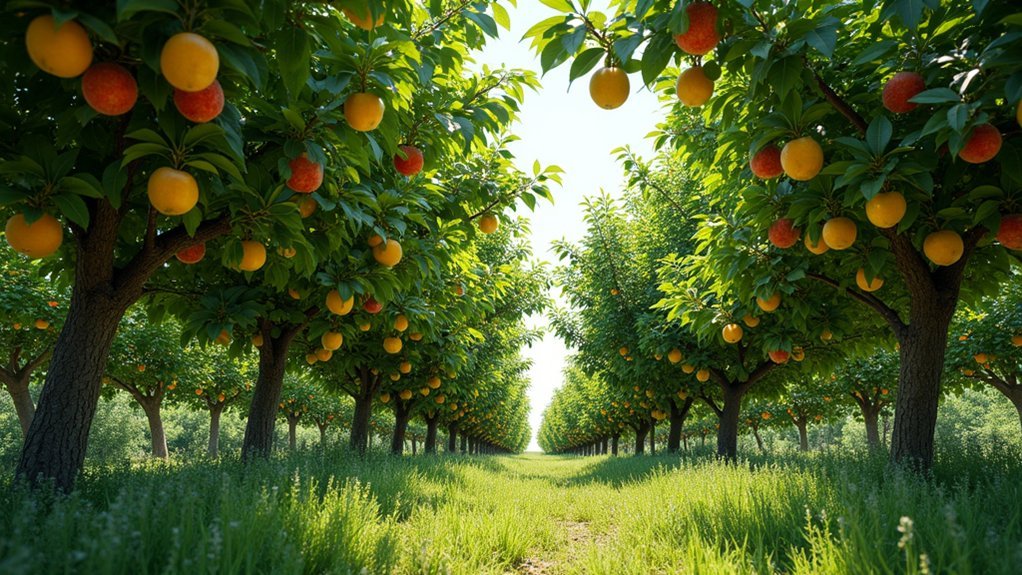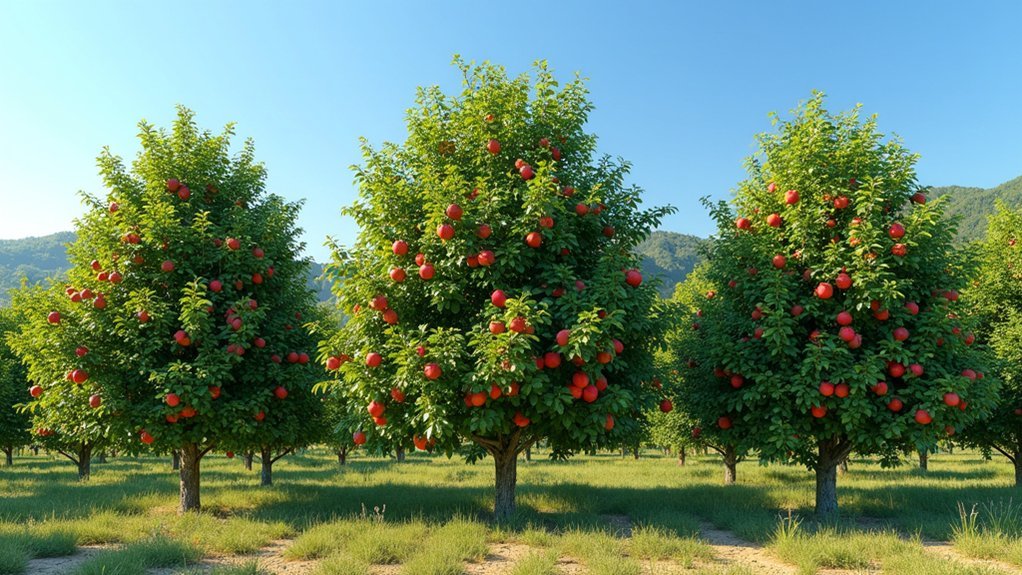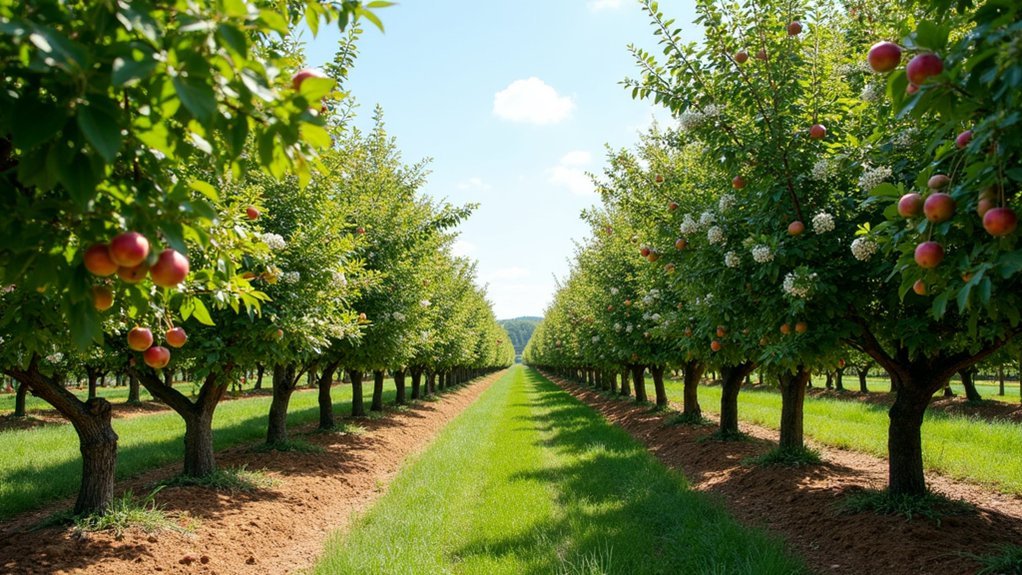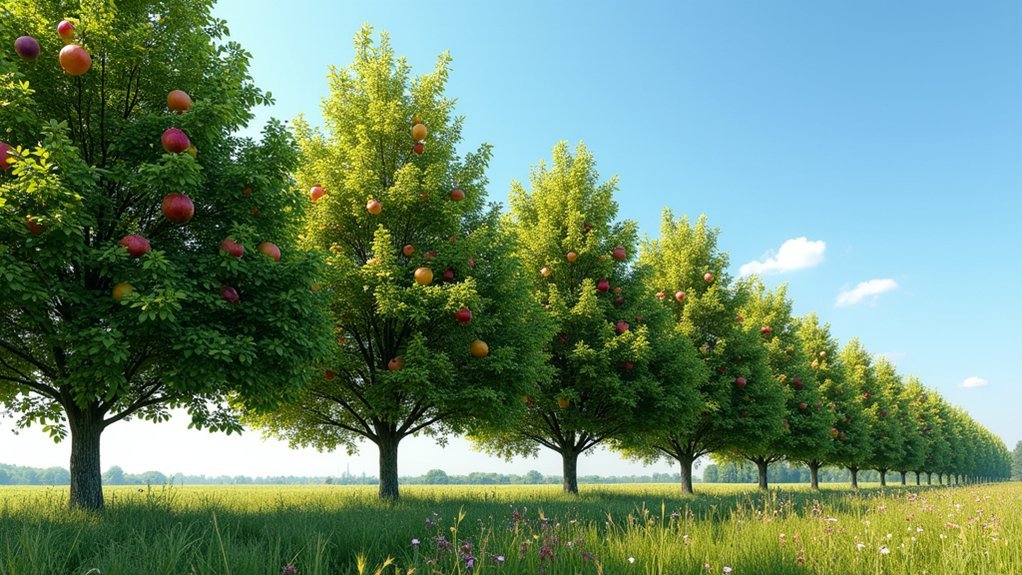Fruit trees can serve dual purposes as windbreaks and food sources. Standard apple and pear trees withstand strong gusts while providing harvests. Plant them in multi-tiered arrangements—taller trees in the center, medium-sized varieties in the middle, and fruiting shrubs on the outside. Space deciduous trees 6.5-13 feet between rows, maintaining 25-50% density for effective protection. You’ll not only reduce wind damage but also boost crop yields by up to 23% and create wildlife habitat simultaneously.
Second-Level Headings for “Fruit Trees That Shield: Natural Windbreak Options”

Five essential headings form the backbone of any thorough guide on fruit trees as windbreaks.
When structuring your windbreak article, consider these key sections: “Selecting Wind-Resistant Fruit Trees” to help you choose varieties like standard apple and pear that withstand strong gusts while producing food.
“Multi-Tier Planting Strategies” explores how layering different heights creates more effective protection, with tall walnuts and pecans above medium fruit trees.
“Economic Benefits” should highlight both the potential 10-20% energy savings for your home and the impressive crop yield increases of up to 23%.
“Biodiversity Advantages” can examine how fruit trees attract beneficial wildlife.
Finally, “Seasonal Maintenance” gives practical advice for keeping your productive windbreak healthy year-round, ensuring it continues to shield while feeding your family.
Benefits of Dual-Purpose Windbreak Trees
Dual-purpose windbreak trees offer you the unique advantage of harvesting fruits or nuts while protecting your primary crops from harsh winds.
You’ll see crop yields increase by up to 23% for wheat and save 10-20% on energy costs, creating a climate-resilient growing environment that withstands extreme weather.
Beyond immediate benefits, these productive barriers sequester significant carbon—up to 21 metric tons per acre by year 20—while providing valuable wildlife habitat and extending their protective reach up to 20 times their height.
Protective Food Production
While traditional windbreaks serve the primary purpose of wind protection, dual-purpose edible windbreaks offer a remarkable combination of benefits for your land.
These strategic plantings protect crops from damaging winds while producing food and enhancing your property’s ecosystem.
The data confirms their effectiveness:
- Crop yield increases – Wheat yields rise by 23%, soybeans by 15%, and corn by 12% when protected by these natural shields.
- Energy efficiency – Your rural home energy costs can drop 10-20% thanks to wind reduction.
- Carbon sequestration – Edible windbreaks store up to 21 metric tons of CO2 per acre over 20 years.
You’ll enjoy multiple harvests while creating a layered design that maximizes biodiversity.
With proper maintenance, you’ll join the 72-99% of satisfied producers who’ve adopted this dual-purpose approach.
Climate-Resilient Crop Boosting
As climate challenges intensify across agricultural regions, dual-purpose windbreak trees offer a powerful defense system that simultaneously boosts crop production.
You’ll see remarkable yield increases—wheat by 23%, soybeans by 15%, and corn by 12%—when you implement these strategic plantings on your farm.
These trees create protected zones extending up to 20 times the height of your tallest specimens, considerably reducing wind damage while sequestering approximately 21 metric tons of CO2 per acre by age 20.
You’re not just growing food; you’re building climate resilience.
The benefits extend beyond your fields, cutting rural home energy costs by 10-20% through wind protection.
Harvest While Sheltering
Transforming your windbreak into a food forest creates a practical strategy that yields both protection and produce from the same valuable acreage.
By integrating fruit trees into your windbreak design, you’ll create a dual-purpose system that serves multiple functions simultaneously.
Your strategic planting pays dividends through:
- Extended harvesting cycles – Diverse fruit trees provide staggered yields throughout the year while continuously protecting crops.
- Carbon sequestration – Mature fruit trees can store up to 21 metric tons of CO2 per acre by age 20.
- Significant yield increases – Crops protected by these living barriers show remarkable productivity boosts—up to 23% for wheat and 15% for soybeans.
This layered approach with tall, medium, and shrub-sized fruit trees maximizes protection reach—up to 20 times the height of your tallest trees.
Top Fruit Tree Species for Windbreak Protection
Five exceptional fruit tree varieties stand out as premier choices for effective windbreak protection.
Standard apple trees top the list, providing shelter for areas up to 20 times their height while delivering annual harvests.
Standard apple trees create extensive windbreaks, sheltering areas twenty times their height while rewarding you with bountiful yearly harvests.
Semi-dwarf pears offer an excellent middle-layer option, combining modest height with substantial wind resistance and reliable fruit production.
For diversifying your windbreak, consider serviceberries, which thrive in varied conditions while attracting beneficial wildlife.
Elderberries create dense lower barriers, filling gaps where wind might penetrate beneath taller fruit trees.
Currants round out an effective windbreak system, tolerating partial shade beneath larger trees.
When selecting fruit trees for your windbreak, prioritize species adapted to your local climate and soil conditions, spacing them properly to maximize both wind protection and fruit production potential.
Design Principles for Edible Windbreak Barriers

Creating effective edible windbreaks requires strategic design that balances protection with production. Your windbreak should maintain a height-to-length ratio of 1:10 to minimize turbulence while providing maximum shelter. Aim for 25-50% density with one row of shrubs and two rows of trees for general protection, or 65%+ density for maximum defense.
- Layer strategically – Incorporate tall trees, medium trees, and shrubs in a graduated structure that optimizes both wind protection and food production.
- Mix deciduous and coniferous species – This guarantees year-round coverage and supports biodiversity in your landscape.
- Space properly – Plant shrubs 3-6 feet apart and deciduous trees 12-20 feet apart to allow healthy growth while maintaining windbreak integrity.
Always select plants compatible with your USDA hardiness zone for long-term success.
Strategic Planting Techniques for Maximum Wind Reduction
You’ll achieve maximum wind reduction by creating a multi-layer defense system with tall canopy trees, mid-story specimens, and understory shrubs planted perpendicular to prevailing winds.
Design your planting pattern using the 1:10 height-to-length ratio, spacing trees appropriately to maintain 25-65% density for ideal wind diffusion without creating turbulence.
Combine deciduous and evergreen species strategically throughout your windbreak to guarantee year-round protection against seasonal wind patterns while supporting biodiversity.
Multi-Layer Wind Defense
While single-row plantings offer some protection, a multi-layered windbreak provides superior defense against harsh winds through strategic arrangement of vegetation at various heights.
Your ideal windbreak should maintain a 1:10 height-to-length ratio to minimize turbulence and maximize Soil and Water Conservation benefits.
For effective multi-layer wind defense, aim for:
- Plant density of 25-65% – Using one row of deciduous shrubs and at least two rows of trees for maximum energy savings
- Strategic positioning – Plant taller species at the windward center with shorter vegetation radiating outward
- Species diversity – Combine deciduous and evergreen plants for year-round protection while enhancing biodiversity
Regular maintenance through annual pruning and proper spacing guarantees your windbreak remains effective long-term while supporting cross-pollination between fruit-bearing species.
Distance-Based Planting Patterns
Strategic spacing forms the foundation of any successful windbreak, determining both its effectiveness and longevity. When implementing distance-based planting patterns, position deciduous trees and shrubs 6.5–13 feet between rows to optimize airflow while maintaining protection.
For small trees, space them 10–15 feet apart within rows and allow 20 feet between rows to accommodate mature growth.
Your windbreak’s effectiveness multiplies when you adopt a layered approach—tall trees centered, medium-sized varieties on outer edges, and shrubs at the base—creating protection up to 20 times their height.
Tailor your planting density to your specific goals: 25–50% density works well for crop protection, while denser plantings (65%+) maximize energy savings and wildlife habitat.
Mix deciduous and coniferous species for year-round wind resistance.
Seasonal Protection Planning
Seasonal protection requires a thoughtful approach that builds upon proper spacing techniques. For effective year-round windbreaks, you’ll need to combine deciduous and evergreen species strategically. Aim for a density of 25-50% with one row of deciduous shrubs and two rows of trees to achieve ideal wind diffusion, which can boost crop yields by up to 23%.
Your seasonal protection planning should include:
- Multi-storey planting with taller trees sheltering lower fruit-bearing plants
- Spring-blooming fruit trees alongside evergreens for dual-purpose protection
- Species selection based on your local hardiness zone for maximum effectiveness
When properly designed, these windbreaks can extend protection up to 20 times the height of your tallest trees while contributing to biodiversity and maximizing land use through edible options.
Seasonal Considerations for Fruit-Bearing Windbreaks
Effective planning for fruit-bearing windbreaks requires careful attention to the changing seasons and their impact on both protection and production.
Seasonal timing is critical, as spring flowering can be damaged by high winds, greatly reducing your harvest potential.
Spring bloom timing can make or break your seasonal harvest when windbreak planning overlooks flowering protection.
Select species that flower later in spring to avoid damage from late winter storms or spring gales.
You’ll benefit from incorporating diverse fruit trees that not only shield your property but also provide staggered harvests throughout the growing season.
Consider height and density carefully—your windbreak shouldn’t shade fruit-bearing trees that need full sun to produce well.
Don’t neglect maintenance during the growing season; regular pruning and pest monitoring are essential for healthy fruit development and maximum yields from your protective barrier.
Multi-Layered Fruit Tree Arrangements for Optimal Protection

When designing your windbreak, a multi-layered approach with fruit trees delivers superior protection while maximizing your land’s productivity.
These structured arrangements can shield areas up to 20 times the height of your tallest trees while supporting biodiversity and improving nearby crop yields by up to 23%.
For effective multi-layered fruit tree arrangements, follow this structure:
- Windward Center – Plant tall nut or large fruit trees as your primary barrier.
- Middle Layer – Add medium-sized fruit trees to diffuse wind and reduce turbulence.
- Outer Layer – Incorporate fruiting shrubs and berries to complete the 25-50% density needed for ideal protection.
Long-Term Maintenance of Productive Windbreak Trees
Although windbreak trees provide essential protection for your property, they require consistent care to maintain their dual function as barriers and food sources.
Prune your trees in late winter or early spring, making clean cuts just outside the branch collar while removing no more than 25% of branches. This timing guarantees proper shape and healing before new growth begins.
Monitor for pest and disease issues regularly—addressing problems like yellowing leaves and twig dieback promptly. Proper spacing between plants not only improves air circulation but can reduce downwind odor by up to 33 percent.
For maximum productivity, plan your harvesting schedule to include spring flowers and fall fruits, keeping plants at manageable heights to eliminate the need for ladders during collection.
This integrated approach guarantees your windbreak remains healthy and productive.
Frequently Asked Questions
What Fruit Tree Can Withstand Wind?
You’ll find apple and pear trees resist wind well due to their sturdy structure. Walnut, persimmon, and fig trees offer great stability with their strong root systems. Citrus trees provide year-round wind protection.
What Is the Best Fruit Tree to Plant Close to a House?
You’ll want to plant dwarf or semi-dwarf apple trees near your house. They’re hardy, manageable at 8-10 feet tall, and provide delicious fruit. Just maintain 10-15 feet spacing for proper air circulation and root development.
What Trees Are Good for Wind Barriers?
You’ll find tall nut trees like walnuts and pecans make excellent wind barriers, protecting areas up to 20 times their height. Add medium fruit trees and berry shrubs in layers for ideal 25-50% density windbreak effectiveness.
How to Protect Fruit Trees From Wind?
To protect your fruit trees from wind, plant them in staggered rows, use taller trees as windward barriers, guarantee proper spacing for circulation, prune regularly for balanced structure, and incorporate evergreens for year-round protection.
In Summary
You’ll enjoy multiple benefits by choosing fruit trees as windbreaks for your property. They’ll provide essential protection while rewarding you with seasonal harvests. Remember to select species suited to your climate, implement strategic multi-layered designs, and maintain your living barrier regularly. With proper planning, your edible windbreak will deliver years of wind protection, privacy, and delicious fruit for your family to enjoy.





Leave a Reply